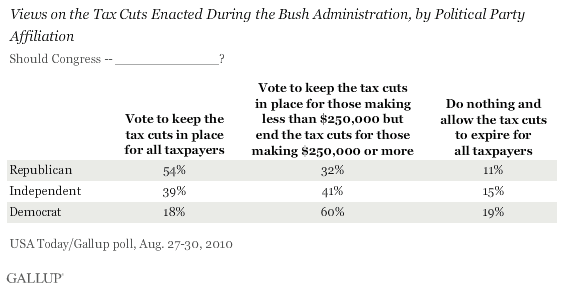Only 1 in 3 Americans actually favor keeping tax cuts for the top 2% (people making over $250,000 a year). As Barry Ritholtz says, that may come as a shocker to anyone who watches CNBC or reads the Journal or Fox or other conservative information sources. Maybe the Democrats aren’t so crazy pushing this as the focus of the upcoming election.
Caroline Baum goes as far as to blame Bush for “the biggest tax increase in history,” saying “Everyone knew or should have known that this was a temporary tax cut (wink, wink) designed to put pressure on future Congresses. After all, no lawmaker wants to run on a platform of: “Vote for me, I raised your taxes.”” The Bush tax cut was “the equivalent of taking out a variable-rate mortgage that is scheduled to increase after five years,” says Veronique de Rugy, a senior research fellow at the Mercatus Center at George Mason University in Arlington, Virginia. “You know the rate is going to go up.” That’s how the law was written, de Rugy says. “By spending like drunken sailors, they almost guaranteed that tax cuts would be in jeopardy in the name of the deficit.” It would have been better, she says, to make the tax cuts permanent and cut spending along the way.
The IMF also plays on the theme of “thinking ahead” by pointing out that we pretty much have a crisis once every decade so, next time – why not plan for it? The IMF proposes a “precautionary credit line” The Fund’s member countries have asked its staff to explore options for overlapping layers of protection for the global economy as well as working on establishing synergies in terms of lending and surveillance with key regional financing arrangements. They are also considering a Global Stabilization Mechanism, a framework that would allow proactive provision of financing during a systemic crisis to stem contagion.

According to the IMF: “Good policies and frameworks—endorsed with FCLs (Flexible Credit Lines) and PCLs—are certainly the first line of defense. However, as history and the recent crisis have shown, there are times when localized events trigger panic among investors, setting off chain reactions across markets and countries irrespective of fundamentals. The intensity of investor withdrawal during the recent crisis surpassed most expectations, with normalcy returning slowly and only after many forceful measures were taken by the global community, including the leaders of the Group of Twenty industrialized and emerging market economies.”






